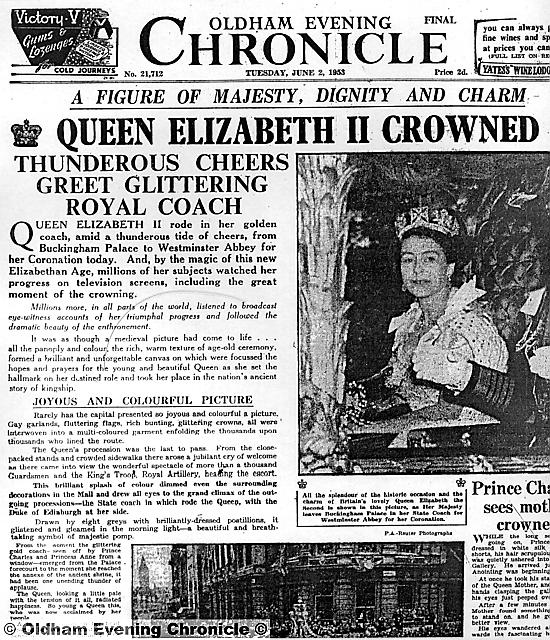The Queen celebrates her date with destiny
Date published: 31 May 2013

THE Chronicle’s special Coronation edition
The Queen reaches an historic anniversary this weekend.
On Sunday, it will be exactly 60 years since the 27–year–old Queen was crowned in Westminster Abbey.
Last year’s Diamond Jubilee of her accession to the throne was a focal point for national celebrations with a river pageant on the Thames involving a flotilla of 1,000 boats, a concert in front of Buckingham Palace and a traditional service of thanksgiving at St Paul’s Cathedral.
The 60th anniversary of the Queen’s coronation in 2013 is a lower–key affair, with commemorations centering on the Queen’s return to her Coronation church with a service for 2,000 guests in the Abbey on Tuesday.
Joined by a strong supporting cast of royals including the Duke of Edinburgh, the Prince of Wales, the Duchess of Cornwall, the Duke and Duchess of Cambridge and Prince Harry, the monarch will listen to an address by the Archbishop of Canterbury and a reading by David Cameron.
Coronation Day was one of pomp and pageantry as thousands took to the streets to see the Queen’s procession. An estimated 27 million people in Britain watched the ceremony, steeped in 1,000 years of history, on television, while more than 8,200 guests were seated in the Abbey.
The Queen has no public events scheduled for the anniversary on Sunday, when she is expected to be at Windsor Castle and attending a church service.
On Monday her engagements will continue as normal, with a reception for the Royal National Institute for the Blind at St James’s Palace. In the summer, a Coronation Festival is being held in the gardens of Buckingham Palace from July 11-14.
For its annual summer opening this year, Buckingham Palace will stage a special exhibition dedicated to the Coronation and display the Coronation outfits worn by the Queen and other members of the Royal Family.
Amid the celebrations, the royals are eagerly awaiting the arrival of their newest member who will one day be crowned at his or her own coronation. The Duke and Duchess of Cambridge’s baby — a future king or queen — is due in July.
Coronation factfile
::The Queen was only the sixth Queen to have been crowned in Westminster Abbey in her own right.
::The Coronation service used for Queen Elizabeth II descends directly from that of King Edgar at Bath in 973.
::Coronations are organised by the Earl Marshal, a hereditary position occupied by the Duke of Norfolk.
::A total of 8,251 guests attended the ceremony at Westminster Abbey — 129 nations and territories were officially represented.
::Prince Charles created history when he became the first child to witness his mother’s Coronation as Sovereign.
::The Queen’s white satin Coronation dress was made by Norman Hartnell and embroidered with the emblems of the United Kingdom and the Commonwealth. The embroidery in gold and silver thread and pastel–coloured silks was encrusted with seed pearls and crystals to create a lattice–work effect.
::On her way to the Coronation, the Queen wore the George IV State Diadem — the crown she is depicted wearing on stamps. It was made in 1820 for George IV’s Coronation.
::The Queen’s Coronation service was taken by the Archbishop of Canterbury, whose duty this has usually been since the Norman Conquest in 1066. For the first time at the 1953 Coronation, a representative of another Church, the Moderator of the Church of Scotland, also took part.
::The anointing has the deepest significance during the ceremony. The exact recipe is secret, but the Anointing Oil is known to contain oils of orange, roses, cinnamon, musk and ambergris. Usually a batch is made to last a few coronations. In May 1941, a bomb hit the Deanery destroying the phial containing the anointing oil so a new batch had to be made.
::During the investiture, the Queen put on the newly–made Colobium Sindonis — a loose linen–lawn garment — and then a robe of cloth of gold, the Dalmatic or Supertunica, which was used by George VI. The Lord Great Chamberlain presented the golden spurs, the symbol of chivalry, after which the Archbishop of Canterbury presented a jewelled sword, and then the armills, the golden bracelets of sincerity and wisdom. Finally, the Queen put on a stole and cloth of gold the Robe Royal and received the orb, the Coronation ring, the glove and the sceptre.
::The St Edward’s Crown, made in 1661, was the crown placed on the Queen’s head during the Coronation service. In its current form, it was first used by Charles II but it is thought that the lower part might be from Edward the Confessor’s crown.
::The orb, also made in 1661, is a globe of gold surrounded by a cross girdled by a band of diamonds, emeralds, rubies, sapphires and pearls with a large amethyst at the summit.
::The Coronation ring, also known as The Wedding Ring of England, was worn by the Queen on the fourth finger of her right hand in accordance with tradition. It was made for the Coronation of King William IV in 1831.
::The service was the first to be televised and for most people it was the first time they had watched an event on television. An estimated 27 million people tuned in.




